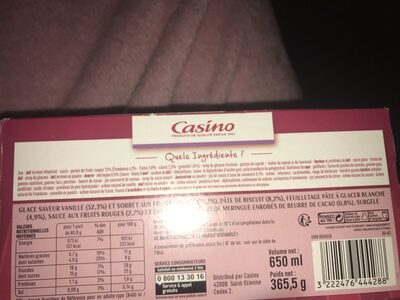Feuilleté glace saveur vanille et fruits rouges - Casino - 365,5 g
This product page is not complete. You can help to complete it by editing it and adding more data from the photos we have, or by taking more photos using the app for Android or iPhone/iPad. Thank you!
×
Some of the data for this product has been provided directly by the manufacturer casino.
Barcode: 3222476444288 (EAN / EAN-13)
Common name: Glace saveur vanille (52.3%) et sorbet aux fruits rouges (31.1%), pâte de biscuit (8.2%), feuilletage pâte à glacer blanche (4.9%), sauce aux fruits rouges (2.7%) et décor de morceaux de meringue enrobés de beurre de cacao (0.8%), surgelé.
Quantity: 365,5 g
Brands: Casino
Categories: Snacks, Desserts, Sweet snacks, Frozen foods, Biscuits and cakes, Frozen desserts, Frozen cakes and pastries
Traceability code: EMB 86092A - Dangé-Saint-Romain (Vienne, France)
Stores: Casino
Countries where sold: France
Matching with your preferences
Environment
Packaging
Transportation
Other information
Conservation conditions: Plusieurs mois dans le compartiment à -18°C d'un congélateur dans la limite de la date de durabilité minimale. Attention : Ne jamais recongeler un produit décongelé !
Recycling instructions - To recycle: Etui carton
Recycling instructions - To discard: Plateau et sachet plastique
Report a problem
Data sources
Product added on by kiliweb
Last edit of product page on by alm1412.
Product page also edited by casino, casino-off, jeremy64, openfoodfacts-contributors, packbot, roboto-app, teolemon, yuka.WTZNZ1BJb2p2dGRYbGYwZnpEck93c0FvNjU3M0JsK05EK1l4SVE9PQ.











